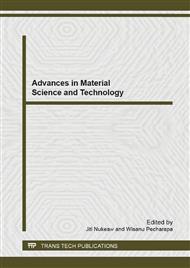[1]
Y. Sasai, N. Matsuzaki, S. Kondo, Y. Yamauchi, and M. Kuzuya, Surface modification of polystyrene dishes using plasma techniques to enhance cell adhesion and proliferation," unpublished.
Google Scholar
[2]
S.-C. Choi, W.-K. Choi, H.-J. Jung, J.-G. Park, B.-C. Chung, Y.-S. Yoo and S.-K. Koh, Relation between hydrophilicity and cell culturing on polystyrene Petri dish modified by ion‐assisted reaction, J. Appl. Polym. Sci. 73 (1999) 41-46.
DOI: 10.1002/(sici)1097-4628(19990705)73:1<41::aid-app5>3.0.co;2-3
Google Scholar
[3]
R. Sipehia, The enhanced attachment and growth of endothelial cells on anhydrous ammonia gaseous plasma modified surfaces of polystyrene and poly (tetrafluoroethylene), Artif. Cell Blood Sub.18(3) (1990) 437-446.
DOI: 10.3109/10731199009117319
Google Scholar
[4]
A. M. Gilliam, A plasma polymerization investigation and low temperature cascade arc plasma for polymeric surface modification (Doctoral dissertation, University of Missouri), 2006.
DOI: 10.32469/10355/4355
Google Scholar
[5]
S. C. Jin, H. S. Baek, Y. I. Woo, M. H. Lee, J. S. Kim, J. C. Park, and I. H. Han, Beneficial effects of microwave-induced argon plasma treatment on cellular behaviors of articular chondrocytes onto nanofibrous silk fibroin mesh, Macromol. Res.17(9) (2009) 703-708.
DOI: 10.1007/bf03218931
Google Scholar
[6]
U. J. Kim, J. Park, H. J. Kim, M. Wada, and D. L. Kaplan, Three-dimensional aqueous-derived biomaterial scaffolds from silk fibroin, Biomaterials. 26(15) (2005) 2775-2785.
DOI: 10.1016/j.biomaterials.2004.07.044
Google Scholar
[7]
Y. Zhao, J. Chen, A. H. Chou, G. Li, and R. Z. LeGeros, Nonwoven silk fibroin net/nano‐hydroxyapatite scaffold: Preparation and characterization, J. Biomed. Mater. Res. A. 27(36) (2006) 6064-6082.
DOI: 10.1002/jbm.a.32272
Google Scholar
[8]
A. Kanjai, and D. Boonyawan, Scaffold preparation from silk fibroin on polystyrene dish by plasma grafting polymerization, Siam Physics Congress (SPC) 2013 proceedings.
DOI: 10.4028/www.scientific.net/amr.802.53
Google Scholar
[9]
Y. Wang, H. J. Kim, G. V. Novakovic, and D. L. Kaplan, Stem cell based tissue engineering with silk biomaterials, Biomaterials. 27(36) (2006) 6064-6082.
DOI: 10.1016/j.biomaterials.2006.07.008
Google Scholar
[10]
T. H. Chung and H. S. Yoon, Scalling laws verification for capacitive rf-discharge Ar plasma using particle-in-cell simulations, J. Appl. Phys. 78(11) (1995) 6441-6447.
DOI: 10.1063/1.360527
Google Scholar
[11]
M. R. Wertheimer, A. C. Fozza and A. C. Hollander, Industrial processing of polymers by low-pressure plasma: the role of VUV radiation, Nuclear Instrument Meth. Phys. Res. B, 151 (1-4) (1999) 65-67.
Google Scholar
[12]
F. J. O'Brien, B. A. Harley, I. V. Yannas and L. J. Gibson, The effect of pore size on cell adhesion in collagen-GAG scaffolds, Biomaterials. 26(4) (2005) 433-41.
DOI: 10.1016/j.biomaterials.2004.02.052
Google Scholar
[13]
S. Tunma, K. Inthanon, C. Chaiwong, J. Pumchusak, W. Wongkham and D. Boonyawan, Improving the attachment and proliferation of umbilical cord mesenchymal stem cells on modified polystyrene by nitrogen-containing plasma, Cytotechnology. 65(1) (2013) 119-134.
DOI: 10.1007/s10616-012-9467-9
Google Scholar
[14]
D. Gogoi, J. Chutia, A. J. Choudhury, A.R. Pal, N. N. Dass, and D. S. Patil, Effect of radiofrequency plasma assisted grafting of polypropylene on the properties of Muga silk yarn, Plasma Chem Plasma Process. 32 (2012) 1293-1306.
DOI: 10.1007/s11090-012-9410-z
Google Scholar


